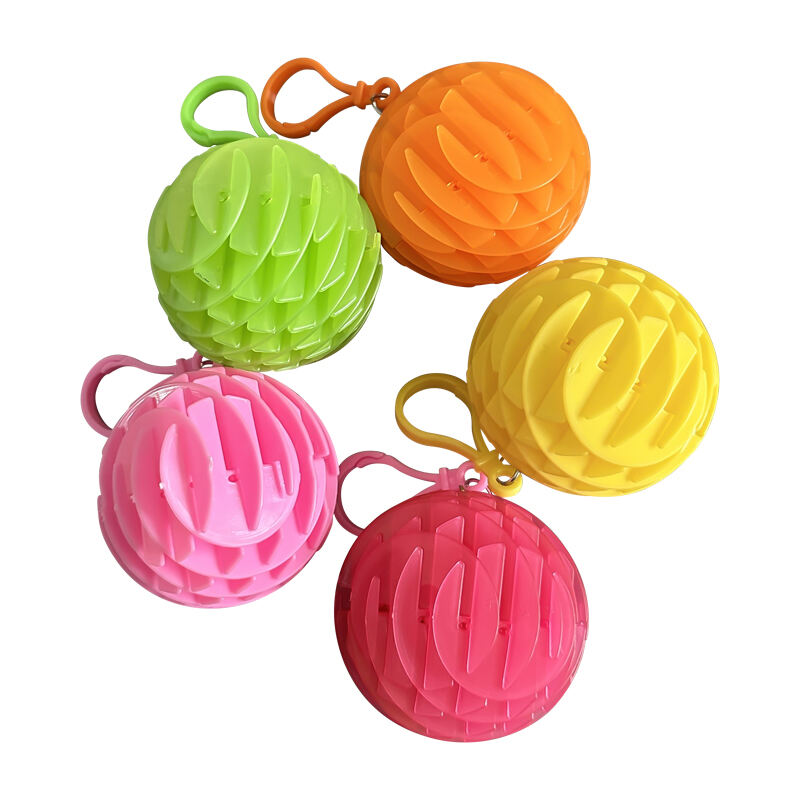The Neuroscience of Anxiety Relief Fidget Toys
How tactile stimulation engages the senses to reduce anxiety
Fidget toys designed to ease anxiety actually stimulate the part of our brains called the somatosensory cortex, where we process all kinds of touch sensations. When someone plays with something textured or moves it repeatedly like spinning or clicking, it creates this constant sensory rhythm that helps take their mind off worrying thoughts. Back in 2006, some researchers looked at what happened when students used stress balls while working on tasks. They noticed these kids paid better attention, about 23% improvement overall, and didn't seem so fidgety or distracted. More recent brain scans back up this idea too. The science shows that when people focus on these physical activities, their brains start making more dopamine. And since dopamine is kind of nature's happy chemical, this extra production can really help stabilize emotions during stressful times.
Neurological mechanisms linking fidget toys to sensory and emotional regulation
When someone fidgets, their body actually releases serotonin, which helps regulate moods. At the same time, it lowers cortisol levels in people who feel anxious, sometimes cutting them down by around 15%. Studies have noticed this happening in real life situations. What makes this interesting is how it works on different parts of the brain. The thinking part, called the prefrontal cortex, gets activated during these movements. Meanwhile, the amygdala, which handles fear responses, tends to quiet down a bit. This combination seems particularly helpful for folks who process sensory information differently. Many report feeling less overwhelmed emotionally after just a couple minutes of using fidget tools, though results can vary from person to person.
Impact of fidgeting on the nervous system and brain stem activity
Fidget toys modulate autonomic nervous system responses by:
| Mechanism | Effect | Time to Benefit |
|---|---|---|
| Rhythmic tactile input | Activates parasympathetic system | 90 seconds |
| Focused hand movements | Lowers heart rate variability | 2 minutes |
| Pressure stimulation | Reduces brainstem hyperarousal | 3 minutes |
This shift from "fight-or-flight" to restful states supports emotional resilience during acute stress.
Scientific evidence on fidgeting, focus, and cognitive performance
Controlled fidgeting enhances concentration without cognitive overload. A UC Davis study showed participants using anxiety relief fidget toys solved complex problems 18% faster than controls. Neurotypical users also benefit—tasks requiring sustained attention see a 30% reduction in errors when fidget tools are combined with visualization techniques.
Sensory Stimulation and Emotional Grounding in Anxiety Management
How Sensory Input Supports Emotional Regulation and Mindfulness
According to recent studies, around 62% of people dealing with anxiety say they feel more emotionally balanced when using things like fidget toys for stress relief (Skill Point Therapy did this research back in 2023). What makes these gadgets work? They seem to calm down the part of our brain responsible for fear responses by giving consistent touch sensations, which helps lower that intense feeling of being on edge. Take someone twirling a ring with different textures for instance. Their mind shifts focus away from worrying thoughts to what their fingers actually feel. This is kind of similar to how mindfulness works, where we learn to stay grounded in whatever is happening right now instead of getting lost in anxious thoughts about the future.
Tactile Benefits of Anxiety Relief Fidget Toys for Sensory Processing
Fidget toys support self-regulation through three key sensory pathways:
- Proprioceptive feedback (pressure from squeezing)
- Vestibular input (subtle motion from rolling)
- Tactile exploration (varied textures like ridges or silicone bumps)
This multi-sensory approach helps recalibrate overstimulated nervous systems. A 2022 behavioral study found participants using textured fidget tools recovered from acute stress 28% faster than non-users.
Linking Fidget Toy Use to Grounding Techniques for Acute Anxiety
Many grounding techniques work by shifting focus away from internal thoughts toward things we can touch or feel, which is why fidget gadgets have become so popular lately. When someone spins around those little clicky cubes or plays with stretchy cords, they get instant feedback from their senses that helps break the cycle of worrying thoughts. Some studies published in BMC Psychiatry back this up, finding about a third drop in panic symptoms after just five minutes with these kinds of toys. Of course, nobody should rely solely on them for mental health issues, but practitioners find they really help when used alongside traditional talk therapies. The physical distraction gives people something concrete to hold onto when emotions start getting overwhelming.
Cognitive Distraction and Focus Redirection Through Fidgeting
Using Anxiety Relief Fidget Toys to Interrupt Rumination and Anxious Thoughts
Fidget toys designed to relieve anxiety actually interrupt those endless thinking loops by giving the hands something physical to focus on instead of letting the brain spin out of control. Research from the UC Davis MIND Institute in 2024 showed that when people used these textured gadgets while dealing with stressful situations, they had about 32 percent fewer unwanted thoughts popping into their heads compared to folks who didn't use them. Similar findings came out of studies at the University of Illinois too, where scientists noticed that quick breaks involving different senses can refresh our mental energy levels. This helps us step back from negative thought patterns without completely losing track of whatever we were supposed to be doing in the first place.
The neurological basis involves the reticular activating system (RAS), a brainstem network regulating alertness. Fidgeting provides mild stimulation that maintains RAS activity within an optimal range—avoiding both mental fog and sensory overload.
How Redirected Focus Through Motion Supports Mental Clarity
Moving things around with controlled motions such as spinning a fidget ring or squeezing putty actually stimulates the part of the brain called the somatosensory cortex. This creates what researchers call a sort of mental foothold that helps keep focus steady without needing to look at something constantly. The non-visual kind works really well too. Some classrooms have found that when students use quiet fidget tools during tests, their scores go up between 15 to 18 percent according to research published last year in the Journal of Educational Psychology. These little gadgets work on different parts of our nervous system so they take pressure off the main thinking areas of the brain. That means more space opens up for solving problems while still staying alert enough to notice important details.
Fidget Toys for ADHD, PTSD, and Stress-Related Conditions
Improving Attention and Concentration in ADHD with Repetitive Tactile Input
Fidget toys designed for anxiety relief might actually help people with ADHD stay focused better because they provide controlled sensory stimulation. Research published back in 2021 looked at kids in classrooms who used those spinning gadgets everyone was obsessed with for a while. The results indicated something interesting - students spent about 22 percent more time paying attention to what was happening in class when they had these toys around. What seems to happen is that the constant movement activates parts of the brain responsible for sensing touch, creating sort of mental anchor point that helps curb sudden impulses to wander off task. Most professionals suggest going for quieter options though, like squishy putty that changes shape or those little silicone wheels that roll between fingers, so they don't become a distraction themselves but instead support concentration efforts without getting in the way of actual learning.
Managing Hyperarousal in PTSD Using Fidget-Based Rapid Stress Techniques
Fidget tools can be really helpful for people dealing with PTSD as they act like quick grounding techniques that pull attention away from emotional triggers towards something physical instead. Research published back in 2018 by Occupational Therapy International found that when adults used stress balls during their exposure therapy sessions, about one third fewer people reported feeling anxious afterwards. The simple act of moving both hands while squeezing or turning these tools seems to activate parts of the brain stem, which might help calm down the body's fight-or-flight response. This kind of activity appears to slow down heart rate fluctuations that are common when someone is in a state of heightened alertness.
Controversy and Considerations: Are Anxiety Relief Fidget Toys Overused or Misunderstood?
Benefits have been documented plenty of times, but there's growing concern about relying too much on these tools. Recent research from Pediatric Psychology back in 2023 showed mixed results across ADHD studies, with around 4 out of 10 actually finding no real improvement in attention span. Teachers are worried about overuse too. A survey conducted in 2022 found that nearly one fifth of educators noticed students developing compulsive fidgeting habits even when doing simple classroom activities without stress. The key seems to be finding the right balance. Experts suggest combining physical tools with proven therapeutic approaches such as cognitive behavioral therapy to help develop lasting coping strategies rather than temporary fixes.
FAQ
What are the benefits of using fidget toys for anxiety?
Fidget toys help stimulate the somatosensory cortex, increasing dopamine production and stabilizing emotions. They also release serotonin, lower cortisol levels, and can modulate nervous system responses to aid in emotional regulation.
How do fidget toys affect cognitive performance?
Fidget toys enhance concentration without overwhelming cognitive resources. They are shown to help solve complex problems faster and reduce errors in tasks requiring sustained attention when combined with visualization techniques.
Can fidget toys help those with ADHD?
Yes, fidget toys like squishy putty and silicone wheels provide controlled sensory stimulation, allowing those with ADHD to focus better by creating mental anchor points that curb impulses and support concentration without distraction.
Are there any concerns regarding the overuse of fidget toys?
Some research shows mixed results in attention span improvements with potential for compulsive fidgeting. Experts suggest a balanced approach, using fidget toys alongside cognitive behavioral therapies for lasting coping strategies.

